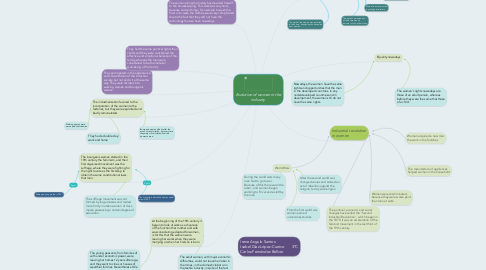Evolution of women in the industry
by Irene AS

1. They participated in the appearance and consolidation of the industrial society, but not all do it at the same way. They were divided into working women and bourgeois women
2. The industrialization favored to the incorporation of the women to the factories, but they were exploited and badly remunerated.
3. Working women were worse paid that the men
4. Bourgeois women didn't suffer the economic exploitation, but every time they were more isolated from the domestic area.
5. The bourgeois women started in the 19th century the feminism, and their first organized movement was the suffrage, where they were fighting for the right to vote as the first step to obtain the same constitutional laws that men.
6. The woman along the history has devoted herself to the housekeeping. This work was very hard, because certain things, for example to wash the floor or to wash the clothes, were very complicated due to the fact that they did not have the technology that we have nowadays.
7. Suffrage was approved in 1931
8. The first pick in which the women voted was in 1933
9. They had the same political rights than childs and they were considered the affective and emotional balance of the family, whereas the men were considered to be the material well-being of the family
10. The young peasants, from families of with under economic power, were leaving her homes 12 years after age, and they went to cities or houses of wealthier families. Nevertheless little money of hher salary was destining it to her family, or to the reservation of the same, necessary to be able to marry.
11. At the beginning of the 19th century it began to look at work as a diversion of the function that mother and wife was considering adapted for women, is for this that the women were leaving her works when they were marrying or when her first son is born.
12. The adult women, with major economic difficulties, could not leave her labor in the mines, in the domestic labor or in the textile industry, in spite of the fact that her salaries were low and lower than those of the men.
13. During the world wars many men had to go to war . Because of this there was little labor , and women began working to fill vacancies left by the men
14. Irene Angulo Santos Isabel Díaz López-Cuervo 3ºC Carlos Fernández Bellver
15. The suffrage movement was not formed by large masses and rooted more firmly in urban women of class media possessing a certain degree of education.
16. They had a double day: work and home
17. Role of the woman out of the home:
18. The work of the woman was to be wife and mother.
19. Work of women was low in prestige and salary
20. The work of a woman out of the home was an indicator of social low class.
21. The work of the women was restricted to the home, exempting the extremely poor women
22. Equality nowadays
23. Nowadays, the women have the same rights and opportunities that the men in the developed countries. In any underdeveloped countries and in development, the women still do not have the same rights.
24. The women's rights nowadays are those of an adult person, whereas before they were the same that those of a child.
25. Industrial revolution in women
26. Women were discriminated, because they were worse paid than men at work.
27. World Wars
28. From the first world war, women earned universities studies
29. After the second world war, changed values and started an act of rebellion against the religion, family and religion
30. The manufacture of appliances helped women in the household
31. Women acquired a new role: the work in the factories
32. The political, economic and social changes have called the "Second Industrial Revolution", which began in the 1870. It was an acceleration of the feminist movement in the last third of the 19th century.


